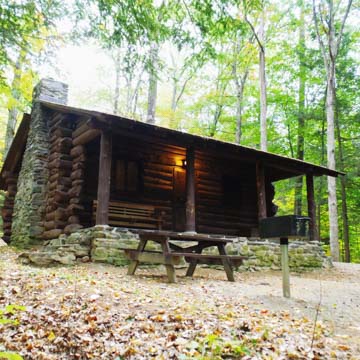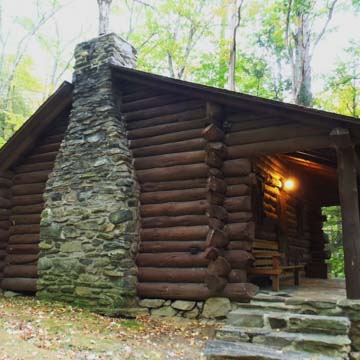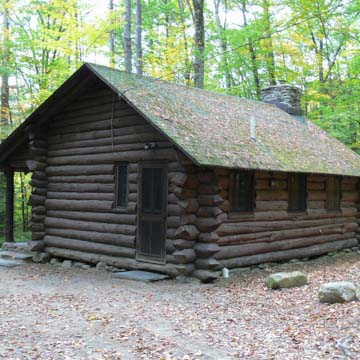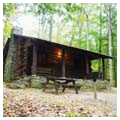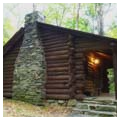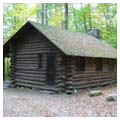Between 1934 and 1935, Camp SP-6 of the 3rd District of the Civilian Conservation Corps (CCC) built four similar rental cabins within Mohawk Trail State Forest, a 6,400-acre preserve in northwestern Massachusetts established by the Commonwealth in 1921. Cabin No. 1, still rentable today as it was originally, offered visitors the chance to spend time in a log cabin (a typology with no historical precedent in the state) amid a constructed wilderness setting. The structure survives as a material connection to an unparalleled investment in recreational facilities located in national and state forests and parks throughout the country and embodies changing notions about Americans’ relationship with the natural world.
Mohawk’s Cabin No. 1 consists of a nearly 19 x 23–foot, dark brown log structure with a gabled roof and covered stone porch. The stacked horizontal logs intersect at right angles in the corners, and their rough-hewn ends extend beyond one another. Built to accommodate a family or small group, Cabin No. 1 contains three rooms. A T-shaped interior partition wall divides the cabin into one large communal area, which comprises half of the space, and a smaller kitchen and bedroom, which are each half the size of the larger room. The common area boasts a table, chairs, and bunks, while the kitchen provides storage and cooking areas. A large stone fireplace rises in the common room. The stone porch connects the interior spaces to a small clearing with a fire ring and grill. A mixed deciduous and evergreen forest surrounds the cabin, and a driveway connected to the State Forest’s entrance road sits next to the cabin.
Cabin No. 1 and its counterparts showcase the impact of the federally funded initiatives to counter the effects of the Great Depression. From 1933 to 1937, the CCC reshaped Massachusetts’s state-owned forests, from Cape Cod to the New York border, as part of its project to complete forest improvement and recreational development projects nationwide. During the program’s peak in 1936, Massachusetts hosted 51 CCC camps that employed 10,000 men who constructed recreational facilities, improved timberlands, enhanced forest fire protection, and mitigated invasive species infestations in state-owned lands. Additionally, these modest log cabins connect the CCC’s federal initiatives with local efforts to strengthen tourism in western Massachusetts in an age of industrial decline.
Massachusetts’s state forest system emerged in the early twentieth century as an effort to reforest vacant agricultural land, preserve natural scenery, and, later, to provide recreational access to nature. The Commonwealth formed the Mohawk Trail State Forest in 1921 specifically to assure the survival of the area’s dramatic vistas created by the Hoosac Mountains, a southerly continuation of Vermont’s Green Mountains. The park’s name relates to a historic Native American pathway that English colonists later used to settle the region. In the early twentieth century, a portion of that pathway was converted to an automobile road that served not only local residents, but also the increasing number of auto tourists who came to Western Massachusetts in search of a wilderness experience. Before the CCC arrived in the area, Mohawk Trail State Forest boasted one of the state’s first automobile camping areas.
The CCC fulfilled two goals of President Franklin Delano Roosevelt’s New Deal program: economic revitalization and natural resource conservation. Dedicated to forest conservation and recreational development, the CCC typically employed young men between the ages of 18 and 25, who served from six months to a year. The enrollees earned $30 a week ($25 of which was sent to their families), worked in a variety of manual labor jobs, and received vocational education in forestry and other areas. In addition to these young men, Roosevelt admitted 25,000 unemployed World War I veterans into the program after veterans groups demanded better compensation for their service. Camp SP-6 was one of these veteran camps and the supervisors at Mohawk Trail State Forest noted that, although they were older and worked more slowly, veteran camps such as SP-6 constructed superior buildings.
Camp SP-6 built Cabin No. 1 using traditional techniques, hand-powered tools, and local materials. Enrollees culled spruce trees from the surrounding forests, stripped them of bark and limbs, and dried them. After building a stone foundation, the veterans carefully fit logs together by hand-carving grooves into the bottom of each log so that it would fit neatly in the one below. The cabin’s walls were built solid, with the windows and doors cut out later. A long log forms the central roof beam with log rafters extending outward. Asphalt shingles have replaced the original handmade hemlock shakes. Large stones from the bed of the nearby Cold River form both the porch and the chimney. Altogether, constructing Cabin No. 1 constituted a painstaking and labor-intensive process. Aside from Cabin No. 1, Camp SP-6 built three other nearly identical cabins, a log administration building, roads, and a since-demolished log crib dam. Another (non-veteran) camp in the area worked on fire prevention, wildlife enhancement, and pest mitigation.
The CCC’s work at Mohawk Trail State Forest and the construction of log cabins for rent reflected both the nationwide growth of outdoor recreation as well as the reshaping of Western Massachusetts into a tourist destination during a period of industrial decline in which many of the regions’ mills closed. Before the Great Depression, rising incomes and the introduction of the automobile led many of Massachusetts’s urban dwellers into the state’s rural hinterlands to seek an experience with nature. The ensuing commercial growth along rural corridors worried both local boosters and tourists, who bemoaned the degradation of the natural scenery due to the intrusion of garish signs and buildings. The Commonwealth created the Mohawk Trail State Forest to divert this growth away from the area’s scenic sites. In the 1930s, National Park Service officials who oversaw CCC recreational construction promoted the log cabin typology as a harmonious addition to the nation’s forest recreation areas. Meant to accommodate urban residents on a short vacation in the rural part of Massachusetts, Cabin No. 1 structured tourists’ experiences through the use of a familiar architectural form and provided them with amenities similar to those they enjoyed at home.
The log cabin carried intense and deep-seated symbolic values for twentieth-century Americans, which were expressed in the Mohawk Trail State Forest. These simple buildings harkened to both a popular image of the nation’s colonial past and the later conquest of western lands. Presidential campaigns in the nineteenth century utilized the log cabin as a symbol of a candidate’s unpretentious origins. In the 1930s, President Roosevelt cast the New Deal as a recapitulation of the nation’s pioneering spirit, of which the log cabin, with its resonance of self-sufficiency, was a vital symbol. On a regional level, boosters imbued western Massachusetts with an imagined frontier past, and the Mohawk Trail was at the center of this mythology. Cabin No. 1 played its small role as a frontier cabin set amidst a wilderness with a mythological Native American trail running through it. Thus, Cabin No. 1 met both federal and local desires by articulating national prerogatives and strengthening the regional construction of cultural heritage.
References
Berg, Shary Page. The Civilian Conservation Corp: Shaping the Forests and Parks of Massachusetts: A Statewide Survey of Civilian Conservation Corps Resources. Boston, MA: Office Historic Resources, Department of Environmental Management, 1999.
Good, Albert H. Park and Recreation Structures. Vol. 3. Washington D.C.: National Park Service, 1938.
Harden, Guy F. “Log Cabin Construction.” Department of Conservation and Recreation, Massachusetts Civilian Conservation Corps Archives, Camp Records, Mohawk Trail State Forest.
Maher, Neil. Nature’s New Deal: The Civilian Conservation Corps and the Roots of the American Environmental Movement. Oxford: Oxford University Press, 2008.
Sutter, Paul S. Driven Wild: How the Fight Against Automobiles Launched the Modern Wilderness Movement. Seattle: University of Washington Press, 2002.





